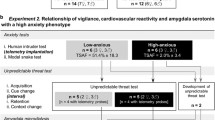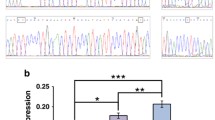Abstract
Anxiety is a normal aspect of human personality, which can manifest in a variety of disorders and other negative traits. The primary treatment for anxiety is the class of drugs known as the selective serotonin reuptake inhibitors (SSRIs), which bind to the serotonin reuptake transporter. The upstream region of the gene that codes for this transporter contains a polymorphism that is an insertion/deletion event that in turn, produces long (l) and short (s) alleles in the population. This particular polymorphism in the serotonin transporter, the 5HTTLPR (serotonin transporter linked polymorphic region), is thought to be involved in the genesis of anxious traits and disorders. Most studies with human subjects have examined adult behavior, which may derive from diverse experiential and environmental backgrounds, as well as genetic differences. To better isolate the effect of genetics, we genotyped 128 infant and juvenile monkeys for the 5HTTLPR and tested for behavioral response in four testing paradigms designed to elicit fearful-anxious behaviors: a free play, remote-controlled car, human intruder, and novel fruit test. The s/s monkeys were found to be behaviorally inhibited in the free play test, engaged in more fear behaviors in the remote-controlled car test, and threatened more in the stare portion of the human intruder test, even though a small number of monkeys were assessed. There was no difference between genotypes of either sex in the prolactin response to fenfluramine. These data indicate greater anxiety in the s/s monkeys for distinct facets of anxious behavior, which are independent of a global neurohormonal challenge test. These neurobehavioral data support recent neuroimaging findings in humans indicating the importance of the 5HTTLPR for amygdala-dependent anxious behavior.
Similar content being viewed by others
References
Attwell, D., Barbour, B., and Szatkowski, M. (1993). Nonvescicular release of neurotransmitter. Neuron 11:401-407.
Baldwin, D. V., and Suomi, S. J. (1974). Reactions of infant monkeys to social and nonsocial stimuli. Folia Primatol. 22:307-314.
Ball, S., Smolin, J., and Shekhar, A. (2002). A psychobiological approach to personality: Examinations within anxious outpatients. J. Psychiatr. Res. 36:97-103.
Ballenger, J. C. (2001). Overview of different pharmacotherapies for attaining remission in generalized anxiety disorder. J. Clin. Psychiatry 62(Suppl 19):11-19.
Blakely, R. D., De Felice, L. J., and Hartzell, H. C. (1994). Molecular physiology of norepinephrine and serotonin transporters. J. Exp. Biol. 196:236-281.
Boccia, M. L., Scanlan, J. M., Laudenslager, M. L., Berger, C. L., Hijazi, A. S., and Reite, M. L. (1997). Juvenile friends, behavior, and immune responses to separation in bonnet macaque infants. Physiol. Behav. 61:191-198.
Bondy, B., Erfurth, A., de Jonge, S., Kruger, M., and Meyer, H. (2000). Possible association of the short allele of the serotonin transporter promoter gene polymorphism (5HTTLPR) with violent suicide. Mol. Psychiatry 5:193-195.
Champoux, M., Bennett, A., Shannon, C., Higley, J. D., Lesch, K. P., and Suomi, S. J. (2002). Serotonin transporter gene polymorphism, differential early rearing, and behavior in rhesus monkey neonates. Mol. Psychiatry 7:1058-1063.
Charney, D. S., Grothe, D. R., Smith, S. L., Brady, K. T., Kaltsounis-Puckett, J., Wright, C. W., Laird, L. K., and Rush, A. J. (2002). Overview of psychiatric disorders and the role of newer antidepressants. J. Clin. Psychiatry 63:3-9.
Cleare, A. J., Murray, R. M., and O'Keane, V. (1998). Assessment of serotonergic function in major depression using Dfenfluramine: Relation to clinical variables and antidepressant response. Biol. Psychiatry 44:555-561.
Courtet, P., Baud, P., Abbar, M., Boulenger, J. P., Castelnau, D., Mouthon, D., Malafosse, A., and Buresi, C. (2001). Association between violent suicidal behavior and the low activity allele of the serotonin transporter gene. Mol. Psychiatry 6:338-341.
DeVinney, B. J., Berman, C. M., and Rasmussen, K. L. R. (2001). Changes in yearling rhesus monkeys' relationships with their mothers after sibling birth. Am. J. Primatol. 54:193-210.
de Waal, F. B. (1996). Macaque social culture: Development and perpetuation of affiliative networks. Comp. Psychol. 110:147-154.
Eshleman, A. J., Henningsen, R. A., Neve, K. A., and Janowsky, A. (1994). Release of dopamine via the human transporter. Mol. Pharmacol. 45:312-316.
Falkenburger, B. H., Barstow, K. L., and Mintz, I. M. (2001). Dendrodendritic inhibition through reversal of dopamine transport. Science 293:2465-2470.
Feigon, S. A., Waldman, I. D., Levy, F., and Hay, D. A. (2001). Genetic and environmental influences on separation anxiety disorder symptoms and their moderation by age and sex. Behav. Genet. 31:403-411.
Fitzgerald, M., Malone, K. M., Li, S., Harrison, W. M., McBride, P. A., Endicott, J., Cooper, T., and Mann, J. J. (2003). Blunted serotonin response to fenfluramine challenge in premenstrual dysphoric disorder. Am. J. Psychiatry 154:556-558.
Goldsmith, H. H., Bradshaw, D. L., and Rieser-Danner, L. A. (1990). Temperament as a potential developmental influence on attachment. New Dir. Child Dev. 31:5-34.
Greist, J. H., Marks, I. M., Baer, L., Kobak, K. A., Wenzel, K. W., Hirsch, M. J., Mantle, J. M., and Clary, C. M. (2002). Behavior therapy for obsessive-compulsive disorder guided by a computer or by a clinician compared with relaxation as a control. J. Clin. Psychiatry 63:138-145.
Hariri, A. R., Mattay, V. S., Tessitore, A., Kolachana, B., Fera, F., Goldman, D., Egan, M. F., and Weinberger, D. R. (2002). Serotonin transporter genetic variation and the response of the human amygdala. Science 297:400-403.
Heath-Lange, S., Ha, J. C., and Sackett, G. P. (1999). Behavioral measurement of temperament in male nursery-raised infant macaques and baboons. Am. J. Primatol. 47:43-50.
Heils, A., Teufel, A., Petri, S., Stober, G., Riederer, P., Bengel, D., and Lesch, K. P. (1996). Allelic variation of human serotonin transporter gene expression. J. Neurochem. 66:2621-2624.
Hessl, D., Dyer-Friedman, J., Glaser, B., Wisbeck, J., Barajas, R. G., Taylor, A., and Reiss, A. L. (2001). The influence of environmental and genetic factors on behavior problems and autistic symptoms in boys and girls with fragile X syndrome. Pediatrics 108:E88.
Jorm, A. F., Prior, M., Sanson, A., Smart, D., Zhang, Y., and Easteal, S. (2000). Association of a functional polymorphism of the serotonin transporter gene with anxiety related temperament and behavior problems in children: A longitudinal study from infancy to the mid-teens. Mol. Psychiatry 5:542-547.
Kalin, N. H. (2003). Nonhuman primate studies of fear, anxiety, and temperament and the role of benzodiazepine receptors and GABA systems. J. Clin. Psychiatry 64(Suppl. 3):41-44.
Kalin, N. H., and Shelton, S. E. (1989). Defensive behaviors in infant rhesus monkeys: Environmental cues and neurochemical regulation. Science 243:1718-1721.
Kumakiri, C., Kodama, K., Shimizu, E., Yamanouchi, N., Okada, S., Noda, S., Okamoto, H., Sato, T., and Shirasawa, H. (1999). Study of the association between the serotonin transporter gene regulatory region polymorphism and personality traits in a Japanese population. Neurosci. Lett. 263:205-207.
Lesch, K. P., Bengel, D., Heils, A., Sabol, S. Z., Greenberg, B. D., Petri, S., Benjamin, J., Muller, C. R., Hamer, D. H., and Murphy, D. L. (1996). Association of anxiety related traits with a polymorphism in the serotonin transporter gene regulatory region. Science 274:1527-1530.
Lesch, K. P., Meyer, J., Glatz, K., Flugge, G., Hinney, A., Hebebrand, J., Klauck, S. M., Poustka, A., Poustka, F., Bengel, D., Mossner, R., Riederer, P., and Heils, A. (1997). The 5-HT transporter gene-linked polymorphic region (5-HTTLPR) in evolutionary perspective: Alternative biallelic variation in rhesus monkeys. J. Neural Transm. 104:1259-1266.
Lin, D., and Parsons, L. H. (2002). Anxiogenic-like effect of serotonin( 1B) receptor stimulation in the rat elevated plus-maze. Pharmacol. Biochem. Behav. 71:581-587.
Melartin, T. K., Rytsala, H. J., Leskela, U. S., Lestela-Mielonen, P. S., Sokero, T. P., and Isometsa, E. T. (2002). Current comorbidity of psychiatric disorders among DSM-IV major depressive disorder patients in psychiatric care in the Vantaa Depression Study. J. Clin. Psychiatry 63:126-134.
Morley, K. C., Gallate, J. E., Hunt, G. E., Mallet, P. E., and McGregor, L. S. (2001). Increased anxiety and impaired memory in rats 3 months after administration of 3,4-methylenedioxymethamphetamine (“Ecstacy”). Eur. J. Pharmacol. 433:91-99.
Newman, M. E., Shapira, B., and Lerer, B. (1998). Evaluation of central serotonergic function in affective and related disorders by the fenfluramine challenge test: A critical review. Int. J. Neuropsychopharmacol. 1:49-69.
O'Keane, V., and Dinan, T. G. (1991). Prolactin and cortisol responses to D-fenfluramine in major depression: Evidence for diminished responsivity of central serotonergic function. Am. J. Psychiatry 148:1009-1015.
Ollendick, T. H., and Hirshfeld-Becker, D. R. (2002). The developmental psychopathology of social anxiety disorder. Biol. Psychiatry 51:44-58.
Osher, Y., Hamer, D., and Benjamin, J. (2000). Association and linkage of anxiety related traits with a functional polymorphism of the serotonin transporter gene regulatory region in Israeli sibling pairs. Mol. Psychiatry 5:202-216.
Persico, A. M., Mengual, E., Moessner, R., Hall, S. F., Revay, R. S., Sora, I., Arellano, J., DeFelipe, J., Gimenez-Amaya, J. M., Conciatori, M., Marino, R., Baldi, A., Cabib, S., Pascucci, T., Uhl, G. R., Murphy, D. L., Lesch, K. P., Keller, F. (2001). Barrel pattern formation requires serotonin uptake by thalamocortical afferents, and not vesicular monoamine release. J. Neurosci. 21:6862-6873.
Plomin, R., Owen, M. J., and McGuffin, P. (1994). The genetic basis of complex human behaviors. Science 264:1733-1739.
Reist, C., Mazzanti, C., Vu, R., Tran, D., and Goldman, D. (2001). Serotonin transporter promoter polymorphism is associated with attenuated prolactin response to fenfluramine. Am. J. Med. Genet. 105:363-368.
Rothman, R. B., and Baumann, M. H. (2002). Serotonin releasing agents: Neurochemical, therapeutic and adverse effects. Pharmacol. Biochem. Behav. 71:825-836.
Rudnick, G., and Wall, S. C. (1992). The molecular mechanism of “ecstasy” [3,4-methylenedioxy-methamphetamine (MDMA)]: Serotonin transporters are targets for MDMA-induced serotonin release. Proc. Natl. Acad. Sci. USA 89:1817-1821.
Salichon, N., Gaspar, P., Upton, A. L., Picaud, S., Hanoun, N., Hamon, M., De Maeyer, E., Murphy, D. L., Mossner, R., Lesch, K. P., Hen, R., and Seif, I. (2001). Excessive activation of serotonin (5-HT) 1B receptors disrupts the formation of sensory maps in monoamine oxidase a and 5-HT transporter knock-out mice. J. Neurosci. 21:884-896.
Schwartz, E. A. (1987). Depolarization without calcium can release gamma-aminobutyric acid from a retinal neuron. Science 238:350-355.
Shalev, A. Y. (2001). What is posttraumatic stress disorder? J. Clin. Psychiatry 62(Suppl 17):4-10.
Shuey, D. L., Sadler, T. W., and Lauder, J. M. (1992). Serotonin as a regulator of craniofacial morphogenesis: Site specific malformations following exposure to serotonin uptake inhibitors. Teratology 46:367-378.
Siever, L. J., Murphy, D. L., Slater, S., de la Vega, E., and Lipper, S. (1984). Plasma prolactin changes following fenfluramine in depressed patients compared to controls: An evaluation of central serotonergic responsivity in depression. Life Sci. 34:1029-1039.
Smeraldi, E., Zanardi, R., Benedette, F., di Bella, D., Perez, J., and Catalano, M. (1998). Polymorphism within the promoter of the serotonin transporter gene and antidepressant efficacy of fluvoxamine. Mol. Psychiatry 3:508-511.
Versiani, M., Cassano, G., Perugi, G., Benedetti, A., Mastalli, L., Nardi, A., and Savino, M. (2002). Reboxetine, a selective norepinephrine reuptake inhibitor, is an effective and well-tolerated treatment for panic disorder. J. Clin. Psychiatry 63:31-37
Wilkinson, L. (1989). SYSTAT: The System for Statistics. Evanston, IL: SYSTAT, Inc.
Williamson, D. E., Coleman, K., Bacanu, S. A., Devlin, B. J., Rogers, J., Ryan, N. D., and Cameron, J. L. (2003). Heritability of fearful-anxious endophenotypes in infant rhesus macaques: A preliminary report. Biol. Psychiatry 53:284-291.
Author information
Authors and Affiliations
Rights and permissions
About this article
Cite this article
Bethea, C.L., Streicher, J.M., Coleman, K. et al. Anxious Behavior and Fenfluramine-Induced Prolactin Secretion in Young Rhesus Macaques with Different Alleles of the Serotonin Reuptake Transporter Polymorphism (5HTTLPR). Behav Genet 34, 295–307 (2004). https://doi.org/10.1023/B:BEGE.0000017873.61607.be
Issue Date:
DOI: https://doi.org/10.1023/B:BEGE.0000017873.61607.be




